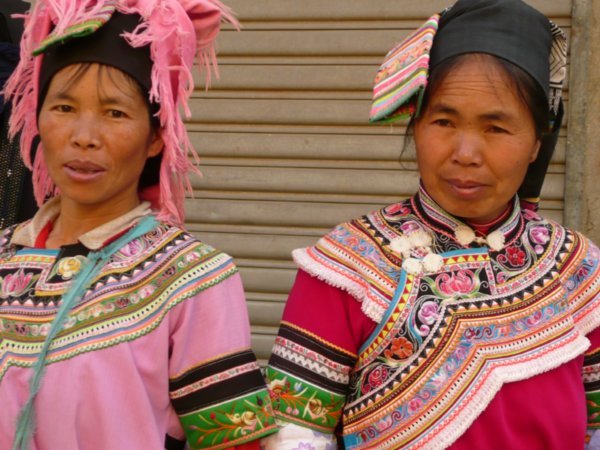Yuanyang
88% of mountainous Yuanyang County’s population are ethnic minorities and 95% are enaged in agriculture. The vast majority of women wear traditional dress every and of 928 settlements 826 are exclusively inhabited by one minority. In other words insular tribal culture has been very well preserved. Add to this the spectacular, millennia-old rice terraces flowing thousands of metres down the mountain slopes over a vast area and you have one of Yunnan Province‘s and indeed South West China‘s real highlights.
Yuanyang town is in fact two towns: uninteresting New Yuanyang (aka Nansha) at an elevation of 240m is connected to Old Yuanyang (aka Xinjie) at an elevation of 1570m by a 27km winding mountain road. Old Yuanyang is the place of interest to travelers and has a couple of guest houses. It has a very colourful ethnic market and is a good place to use as a base for exploration of Yuanyang County. Buses run to Laomeng, Huang Cao Ba and dozens of other villages with exoticcally-dressed local tribal minorities as well as of course to the rice terraces. Guest houses in Yuangyang can also organise private transportation with a driver.
To find out what days local markets are on, ask the owner of Window Of Yuanyang who speaks fluent English. This is a little shop selling goods hand made by ethnic minorities to help them benefit from tourism. The owner is a real fan of ethnic minorities and visiting their markets and seems to know the location and day of the week of almost every single one in Yunnan Province.
The rice terraces, built by the Hani people, cover the mountain slopes over a large area along the road from Old Yuanyang to Laomeng. They look very different depending on what time of year you come. Harvest takes place between September and November depending on the elevation and after this the terraces are filled with water until April. Watching sunrise at this time of year is simply jaw-dropping: at first the water in the terraces reflects the white sky so totally that it looks like it is snow not water, only the brown earth walls of each terrace breaking the total whiteness and forming a huge interlocking pattern of rectangles across the landscape. Then, as the sun comes up, the water starts to glow with fiery oranges, reds and golds which spread across the whole landscape. Planting in the terraces begins in April and after this they are beautiful in a different way, with the lush emerald green of the rice covering the mountain slopes.
The main viewing spots are Duoyishu, Bada and Laohuzui. In the last few years the area has finally received some development for tourism. The good news is that the road has been improved and the viewing spots signposted. The bad news is that you now have to pay to get to them. If you don’t want to pay and have some time to spare you can find other less commercialised but also less spectacular spots to watch sunrise and sunset from. Duoyishu even has a guest house so you can stay here and trek right through the rice terraces up and down the mountains or from village to village without having to pay anything.
Getting to Yuanyang takes about eight hours by bus from Kunming, Yunnan Province‘s capital. It can also be accessed from Xishuangbanna by taking a bus from Jinghong (Xishuangbanna‘s capital) to Jiangcheng then another to Yuangyang (a total of about sixteen hours).
Click here for my blog about Yuanyang. It’s 275 words and 57 photos.

Leave a Reply